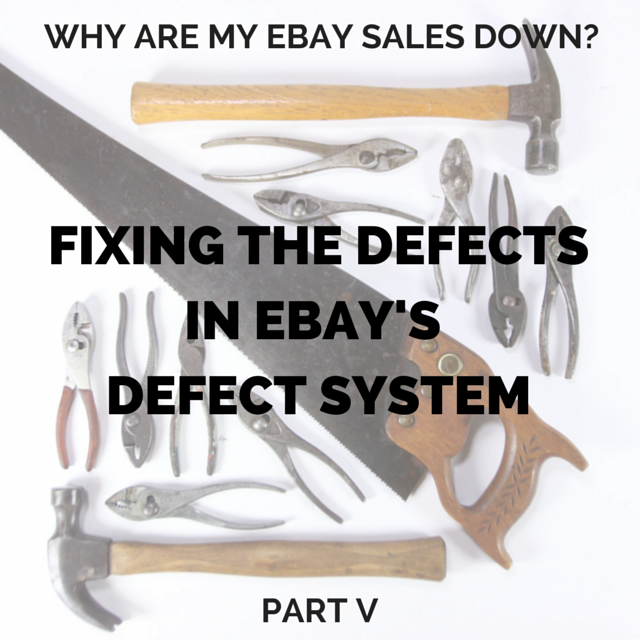Fixing the Defects in eBay's Defect System - Part 5 in a Multi-Part Series

By fall of 2014, things were not looking good for eBay. The spring security breach (read more about this here) and Google algorithm slap (read more about that here) had done major damage to the eBay Marketplace. Additionally, serious competition was making its way onto the eCommerce playing field (more about that here).
What eBay really needed at this point was a major public relations campaign. Long-term eBay sellers needed the reassurance of support from their ecommerce business partner. Sellers needed to hear, “We know times are tough, but we are here for you. We will weather this storm together.” For us, a company who has worked with eBay for the past 10 years (and would like to continue to work with eBay for many more years) this would have been a welcomed gesture. Instead, eBay rolled out one of it’s most unpopular policies ever: the “defect” system.
In early 2014, eBay announced they were once again revising their feedback system. It had been just two years since the last revision, where they introduced stringent new measures by which sellers would be judged. That revision had tipped the advantage heavily toward the buyer, and made selling on eBay more difficult. This new 2014 announcement made the first revision seem mild by comparison. In typical eBay fashion, it was announced as a tool designed to “help sellers by providing a less stringent measuring stick”. That representation could not have been further from the truth.
All sellers on eBay are classified in one of three categories: Top Rated Sellers, Above Standard Sellers and Below Standard Sellers. Sellers who fall into the third category are often banned from continued selling on eBay. To achieve a rating, every transaction is graded by the buyer upon completion. Within that grading system, there is a select set of criteria that, when not met, can result in a “defect”. The accumulation of defects determines the ranking of the seller in the three seller categories. According to eBay, there are seven potential categories where the seller can earn a defect. They are as follows:
- Buyers first rate the overall transaction as positive, neutral or negative. Both a negative and neutral feedback result in a defect.
- Transactions are also graded on a 5-star system in four different categories. These are known as Detailed Seller Ratings, or DSRs. They include “Item as Described”, “Seller Communication”, “Item Shipped Within Stated Time” and “Reasonable Shipping Charges”. Under “Item as Described”, a rating of 1, 2 or 3 stars is considered a low DSR and results in a “defect”.
- Any DSR rating of 1 star for shipping and handling time results in a defect.
- A buyer can also open a case against a seller (at their complete discretion) if they feel as though they have been wronged. Any case opened for “item not described” results in a defect.
- Any return to the seller for “item not as described” results in a defect.
- Any request of “item not received” results in a defect, even if the fault was with the shipping carrier.
- Any transaction cancelled by the seller results in a defect.
While this seems clear-cut, we have found there are also sub-categories to this set of criteria (or “hidden opportunities”) by which a seller can obtain a defect. None of these are explained anywhere that we have found.
The challenge arises for sellers when they are required to maintain a defect rate of less than 2% in order to achieve Top Rated Seller status. For smaller sellers, the grading period is an entire year. Maintaining a rate less than 2% for a year is a near impossibility. For larger sellers, the period is 3 months. This is still a very difficult task, especially when the majority of defects are born from highly subjective categories. These types of penalties are very often handed out by manipulative buyers, or even done in error, as we have documented in our own transactions. Our current “Defect Report” shows that we had nearly 1000 transactions in the past three month period. Of those 1000, only ten transactions resulted in defects. Of those ten, only two were actual mistakes that we made, both of which we resolved completely. The remaining 8 were illegitimate “defects” brought on by buyers who failed to (or were unable to) read the item description or shipment issues far beyond our control.
Regardless of circumstances, these ten defects are enough to raise our defect percent to 1.07%. If we had not diligently challenged other illegitimate defects not mentioned here, we would most certainly be over the allowed 2%, therefore losing our Top Rated Seller status. This would be a costly consequence for many reasons, including the following:
- Top Rated Sellers (TRS) receive a 20% discount on all qualifying Final Value Fees.
- TRS receive a significant boost in eBay search results.
- Having the TRS seal of approval greatly boosts buyers confidence.
In spite of widespread opposition, the defect system rolled out on August 20, 2014. The results have truly been devastating. Well-deserving Top Sellers have lost their status. Many long-time have left the marketplace. Sellers have been forced to spend more time protecting their business, resulting in less time selling. It has created an adversarial relationship between buyers and sellers, as well as between sellers and eBay. Also in result, eBay customer service has been swamped by the fall-out. Their entire system has been bogged down. The average wait time for my two most recent calls to customer service has been over one hour per call.
As a seller, it is always difficult to know how to respond in situations such as this. There are strong opinions as to how things should be, especially when there is so much at stake. We have witnessed many sellers give up and leave the eBay Marketplace altogether. For them, the battle was over. They simply could not survive any longer. Other sellers chose a path of cynicism. They were fed up and took to forums and community pages to passionately express their opinions. While some valid concerns were expressed within these pages, a lot of sellers chose this as their only avenue for sharing their opinion, greatly limiting their reach. They viewed these eBay-hater forums and community pages as the best influence for change on eBay. We were tempted by both, but chose a third route. We decided to try to make a positive difference in the eBay community. We had little confidence about the outcome, but decided to carry our voice a little farther.
Our approach was to contact the executives and policy makers within eBay directly. We were careful in our approach, knowing that they would want documented evidence that their system was not working. We also sought to provide them with positive policy alternatives that may be more effective in accomplishing their stated objectives. Much to our surprise, they were more than willing to listen. The result of our efforts has been more than rewarding.
The good news? It has been confirmed by some high-level contacts that a positive change is on its way. We believe that these changes will be major, and they will drastically improve the eBay experience for sellers. While we are bound by an agreement of confidentiality and unable to give any details, sellers should be aware that those within eBay are listening. The state of eBay’s current feedback and defect system is of high priority to some incoming eBay executives. It is our hope here at RoofTop Antiques that these changes are big enough (and soon enough) to save the eBay Marketplace. For us, and many others, the future depends on it.
See the rest of our eBay series here:
Part I - Why are My eBay Sales Down?
Part II - eBay Takes a Hit
Part III - Google Takes Aim
Part IV - eBay Alternatives?
Part V - Fixing the Defects in eBay's Defect System
Part VI - Breaking Up is Hard to Do: eBay's Split from PayPal
Part VII - Is eBay's Cassini Really the "Best Match"?
Part VIII - Is eBay's Cassini Stuck in Orbit?
The Plan, Part I - Positioning for More than Survival
The Plan, Part II - Expanding Our Reach Beyond eBay
Making Connections
2 Responses
gjcnaknvgr
Muchas gracias. ?Como puedo iniciar sesion?
Leave a comment
Also in View from the RoofTop
Transformation Tuesday - Wall Decor Letters
A New Perspective for Today: An Eloquent Monkey
Frankly, I am not fond of monkeys. They affect me the way spiders and snakes affect other people. The flying monkeys in “The Wizard of Oz” and the rogue monkeys in Robin Williams’s “Jumanji” were menacing to me, and I closed my eyes so I wouldn’t have to see them.
One Day, One Mall, and Four Booths
We headed to Columbia on Saturday morning to meet a new online acquaintance for a furniture trade. I didn't realize it at the time, but the Willett Mid-Century Modern end table she placed in our hands would become the centerpiece for a collection of untold treasures.






Naitipami
May 27, 2021
cheap kamagra paypal